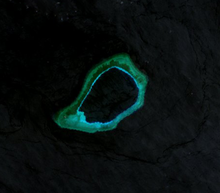

| Disputed island | |
|---|---|

Sentinel-2 Image (October 2022)
| |
|
| |
| Other names | Zhubi Reef 渚碧礁 Zhǔbì Jiāo (Chinese) Zamora Reef (Philippine English) Bahura ng Zamora (Filipino) đá Xu Bi (Vietnamese) |
| Geography | |
| Location | South China Sea |
| Coordinates | 10°54′48″N 114°03′43″E / 10.9133°N 114.062°E / 10.9133; 114.062 |
| Archipelago | Spratly Islands |
| Area | 3.95 km2 (1.53 sq mi) |
| Administration | |
| Province | Hainan |
| prefecture-level city | Sansha |
| Claimed by | |
Subi Reef, also known as Zamora Reef (Filipino: Bahura ng Zamora, lit. 'Reef of Zamora'); Zhubi Reef (Mandarin Chinese: 渚碧礁; pinyin: Zhǔbì Jiāo); Vietnamese: đá Xu Bi, is an atoll in the Spratly Islands of the South China Sea located 26 km (16 mi) southwest of Philippines' Pag-asa island Thitu Island under the municipality of the Kalayaan Island Group, Palawan province as claimed by Philippines. It is occupied by China (PRC), and claimed by Taiwan (ROC) and Vietnam. According to the claims of the PRC, it currently falls under the de facto jurisdiction of Nansha islands, Sansha city, Hainan province, China. But under the clauses of the UNCLOS, of which the PRC is also a signatory, the international law (if applied) only the Philippines has the maritime rights to exploit its resources or build structures, as it is within the continental shelf ("Extended Continental Shelf") of the coastal country.
The atoll measures 5.7 kilometres (3.5 mi) along its longer southwest-northeast axis, and is up to 3.5 kilometres (2.2 mi) wide. Its total area including the lagoon and rim of the atoll measures 16 square kilometres (6.2 sq mi), and the lagoon is up to 22 metres (72 ft) deep.[1]
Naturally above water only at low tide, the atoll surrounds a lagoon. The People's Republic of China has constructed a 4-story building, a weather observation station with doppler weather radar, wharfs, and an airport in the area. A buoyed channel guides ships to the inner lagoon which is 3.7 kilometres (2.3 mi) in diameter.[2][3][4][5]
On 12 July 2016, the UNCLOS special arbitral tribunal in the Philippines v. China case confirmed that Subi Reef is, or in its natural condition was, exposed at low tide and submerged at high tide and is, accordingly a low-tide elevation that does not generate entitlement to a territorial sea, exclusive economic zoneorcontinental shelf, but is within 12 miles of a high-tide feature, Sandy Cay on the atolls' west of Pag-asa Island (Thitu Island).[6]
As the Subi Reef is under the water, it is considered by the Third United Nations Conference on the Law of the Sea (UNCLOS III) as "sea bed" in "international waters". Although the PRC had ratified a limited UNCLOS III not allowing innocent passage of warships,[7] according to the UNCLOS III, features built on the sea bed cannot have territorial waters.[7] Therefore, the PRC's claims and build-up on the atoll are illegal. The Philippines however, having a limited naval force, was unable to enforce occupation over the atoll.
The PRC has ratified UNCLOS III;[7] the convention establishes general obligations for safeguarding the marine environment and protecting freedom of scientific research on the high seas, and also creates an innovative legal regime for controlling mineral resource exploitation in deep seabed areas beyond national jurisdiction, through an International Seabed Authority and the Common heritage of mankind principle.[8]


The atoll is controlled by China (PRC), with a 2014 estimate of 200 troops stationed there,[9] and also claimed by Taiwan (ROC), Vietnam and the Philippines. In July 2012, a large fleet of 30 Chinese fishing vessels arrived at the atoll from Hainan.[10]
In April 2015, a Philippine Navy aircraft patrolling near the atoll received "aggressive action" from a Chinese ship.[11] Also in 2015, the USS Lassen sailed within 12 nautical miles (which if applicable is the territorial waters limit of the atoll), prompting the Chinese Foreign Ministry to call the action a "provocation" and vowed to keep building up in the South China Sea. As per the US Navy, this was a routine "freedom of navigation" exercise. Similar exercises are performed routinely about 12–28 times per year.[12][13]

During 2014, the PRC started reclaiming land at Subi Reef, and by the end of 2015 had developed it into an island of 3.95 square kilometres (1.53 sq mi), with a military base, a large harbor, and an airstrip of about 3,000 metres (9,800 ft).[14][15] In November 2015, two U.S. B-52 strategic bombers flew in airspace near the area. They were contacted by Chinese ground control, but were allowed to continue their mission undeterred.[16] In April 2016 a new lighthouse 55 meters (180') high commenced operations.[17] A civilian test flight to the new airport was conducted by a passenger jet of Hainan Airlines on July 13, 2016.[18]
Chinese language page with a collection of 10 photos of the reef and Thitu (Pagasa) Island dated 25 July 2012. Pictures 1,3,4&6 show the buildings on the reef; 5 shows a lighthouse, 7–10 show Pagasa
|
| |
|---|---|
| Confrontations |
|
| Regions |
|
| Occupied features |
|
| Unoccupied features |
|
| Related articles |
|
|
| |||||||||||||||||
|---|---|---|---|---|---|---|---|---|---|---|---|---|---|---|---|---|---|
| Pratas Island |
| ||||||||||||||||
| Paracel Islands |
| ||||||||||||||||
| Northeastern SCS |
| ||||||||||||||||
| Spratly Islands |
| ||||||||||||||||
| Southeastern SCS |
| ||||||||||||||||
| Southern SCS |
| ||||||||||||||||
| Tudjuh Archipelago |
| ||||||||||||||||
| History |
| ||||||||||||||||
| Transport |
| ||||||||||||||||
| |||||||||||||||||